Developer’s Site || Steam Page
Is it an RTS, is it a tower defense game, or is it something entirely different? Cubetractor is a very odd game about moving cubes to smash enemies and make buildings. You must figure out the best ways to use the cubes at your disposal to quickly build up defenses and defeat your enemies with stationary turrets all while dodging around whatever dangers the game throws your way. This is a fairly challenging game, it’s a one-of-a-kind experience, and best of all it is thoroughly entertaining.
In this game you take on the role of Endroi, a blue robot who is so focused on becoming a Cubetractor master that he starts attacking random fortresses throughout the land while believing them to be Cubetractor exams. It’s a ridiculous premise and it works well alongside plenty of bits of humorous dialogue between various characters, most of whom want to stop Endroi from randomly destroying their stuff. But just what is a Cubetractor? As the name hints at, a Cubetractor is someone who can attract cubes. Specifically, every level is filled with cubes which can be pulled (and only pulled) in a straight line. Cubes can be pulled from anywhere in the level as long is there’s not a mountain in the way and you can even pull cubes at once by rapidly tapping X. The catch here is that once you pull a cube it will keep moving in that direction until it goes offscreen, sinks into water, gets destroyed by crashing into you, rocks, enemies, or an immobile cube, or combines with another moving cube.
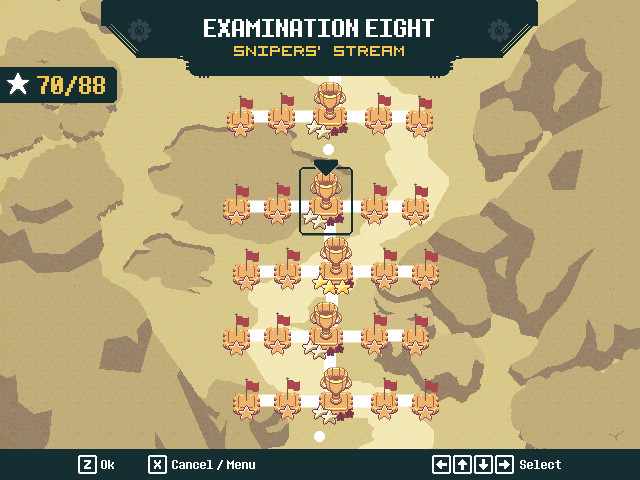
You can kill some enemies by smashing cubes into them and cubes will even remain intact and keep sliding if they deal enough damage to destroy an enemy, but most challenges need to be overcome through combining cubes. There are three types of cubes in the game and when two cubes sliding in opposite directions collide they create a structure at the point of impact. Structures can be manually taken down by walking up to them and pressing X and, since cubes respawn shortly after sliding out of the level or after they or structures they are used to build are destroyed, any structures placed on temporarily empty spaces which normally hold cubes will be instantly destroyed.
There are three offensive structures and three support structures which can be built based on how you combine cubes. You initially only have access to spine cubes so you can only build cannons at the start, which have a fairly long range and periodically shoot sets of three bullets at their targets. It doesn’t take long for the game to mix in earth cubes which can initially only be combined with themselves to create barriers capable of soaking up plenty of damage, but one level after their introduction you can start combining them with spine cubes to create power plants, somewhat fragile and defenseless buildings capable of greatly increasing the firing rate of any friendly buildings placed within a large area around them. Magne cubes are the last of the three to appear and you gradually gain access to the three building types they can create. When magne cubes are combined with spine cubes they create boltguns which rapidly fire with short range, but when combined with themselves magne cubes create spires, which slowly shoot single bullets at specific targets and the bullets can pass over everything except rocks. Spires will prioritize power plants over most other building types, but decoys, the final building type created by combining a magne cube with an earth cube, are specifically designed to be prioritized by spires and non-structural wandering enemies called Meanies take priority over every building type except the decoys and power plants, making spires a powerful but easily diverted tool.
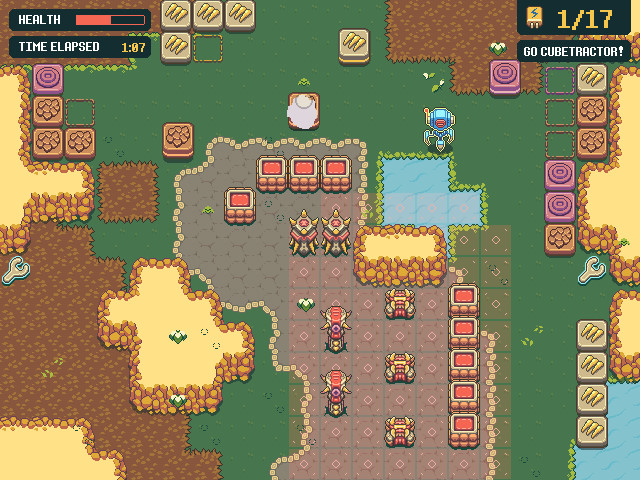
Levels each take place on a single screen and they are fast enough that they rarely last longer than five minutes. This fast pace is an integral part of Cubetractor and it is created primarily thanks to two factors. First, every building other than the barriers can go down in about two or three hits (decoys take reduced damage from spires), but both your own buildings and those you are trying to destroy regenerate health at a steady pace when they aren’t being attacked. This balance of low health and good health regeneration makes it so that particularly slow strategies, such as hitting a structure with a single respawning cube or sniping at anything other than a power plant with a single spire, simply won’t work as the health regeneration will cancel out the damage done by the first hit by the time the second hit lands. Buildings also take a few seconds to activate once they are created so you also can’t rely on sloppier strategies like building an undefended boltgun in front of an enemy fortress or setting up a cannon to take on a set of three cannons aided by a power plant. If an enemy can be hit by cubes it must always be hit by at least two cubes at a time and if you’re setting up structures you must be precise with your positioning as you create and rebuild barriers, power plants, and turrets. Being too slow or not realizing the full extent of the options available to you won’t just cost you a few stars, it’ll make it impossible to complete a level in the first place.
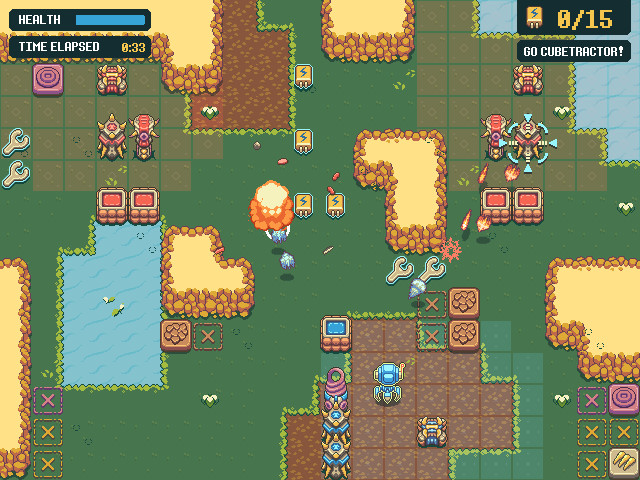
The second reason for the fast pace of the gameplay in Cubetractor is that Endroi himself is an active character. Turrets will target him if you haven’t built any structures within their line of sight and Meanies, which usually respawn indefinitely in later levels, don’t attack your structures at all and instead will always slowly home in on Endroi once they see him. As Endroi will be damaged by his own cubes once he has pulled them, the end result is that players must constantly move around with Endroi to time cube collisions to occur on specific tiles, often by pulling on one cube and then circling behind it to pull on the opposing cube right when both are equidistant from the intended space, all while dodging around enemies, bullets, and your own cubes.
Endroi can take a good number of hits before he goes down and most levels even have some wrenches scattered about which he can use to heal up, but the real danger to enemy attacks lies within their ability to disrupt cube combinations. Acting too quickly while trying to avoid bullets can result in accidentally pulling a cube into one of your own structures, severely damaging it, and not taking the timing of enemy attacks into account can result in pulling on one cube and then suddenly needing to move out of the way and either failing to pull on the second cube before the first one is destroyed or pulling on the second cube at the wrong time and creating a structure in a bad position. However, getting hit is still usually the worst scenario of all because Endroi becomes stunned and can’t get out of the way of any cube he has pulled; Endroi gets plenty of invincibility frames after getting hit, but you’ll have to wait for any cubes which hit him to respawn. There are a few occasions where you can let your turrets do all the work, primarily when waiting for a spire to snipe something, but for the most part the game demands players to always be on the move dodging bullets and pulling cubes while being as precise with their timing as possible.
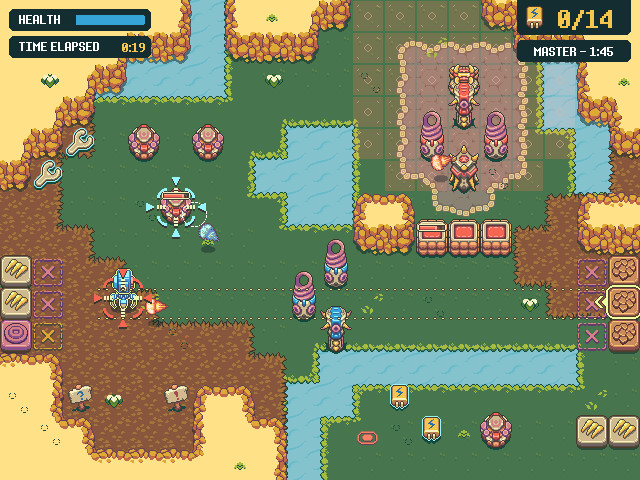
The overall feel of the levels in Cubetractor gradually shifts over the course of the game. Initially, the gameplay feels like a weird hybrid between and RTS and a tower defense game. You’re not ‘defending’ anything, but you are relying on stationary structures with varying ranges, attack speeds, and special abilities and these towers in turn form a sort of base which you must use to overcome the pre-existing base of your opponent. However, the feel gradually shifts over to being more akin to an action puzzle game once the levels become more complicated and more precise positioning becomes required. In early levels you can achieve victory simply by smashing any enemies you can with cubes and then building cannons and power plants just about anywhere within large, open spaces as long as you can protect them with barriers.
The simplistic ways to clear levels gradually fade away once magne cubes start to come into play as you’ll need to position your own cannons and barriers outside of the range of the enemy’s boltguns, which are almost always aided by a power plant or two, while figuring out how to safely place your own boltguns close enough to enemy structures to destroy them. The introduction of spires and decoys is when the full transition to an action puzzle game feels complete as you need to decipher how to take out every enemy decoy in advance so that you can then position a spire in the exact spot from which it can hit an enemy power plant without being in the line of sight of enemy cannons and then possibly building boltguns to consistently take out any enemy Meanies so that your spires won’t get distracted from targeting other structures all while building your own decoys against enemy spires. The more intricate details of how each type of turret prioritizes targets simply aren’t all that noticeable until spires come into play and once that happens the complexity of the solution to each level dramatically increases.
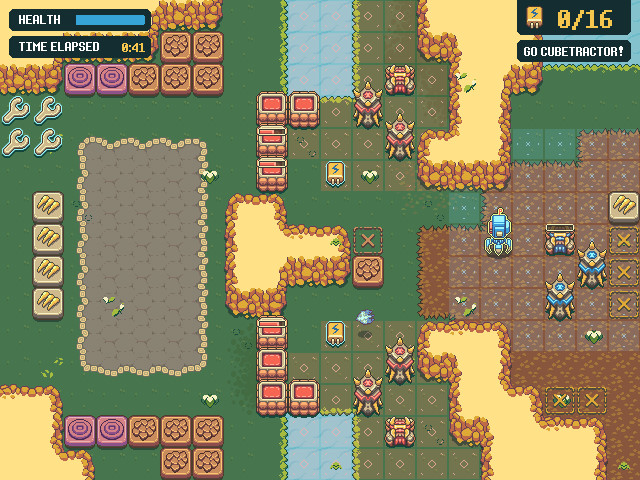
Cubetractor‘s biggest weakness is that it is short in a way which leaves you feeling like there really should be more. Not including a handful of tutorial levels, there are 48 levels in the game, which sounds like a good number until you realize that most of these levels can be completed in under five minutes and often even under three. Of these 48 levels, 12 of them are exam levels, which serve as the main campaign of the game, and the rest are side levels. Every exam from the fourth to the levels has a set of two side levels on its left and another set of two side levels on its right which can be accessed upon completing it. The only objective of these side levels is to defeat every enemy and pick up the batteries they drop and each side level earns you one star.
Exams are more complicated as the earlier exams consist of three short levels back-to-back and the later exams consist of one or two rather involved levels and you get a star rating based on your performance. Clearing an exam earns you a bronze star, simply picking up every battery along the way earns you a silver star, picking up every battery within a time limit earns a gold star, and to achieve full mastery you must get every battery within a very strict time limit all without taking any damage. The stars certainly add in an element of replayability to the exam levels and attempting to get a master rating on every level will just about anyone far, far more time than it would take to simply complete the game, but the problem here is that the stars simply don’t do anything. As of this time I have 70 of the 88 possible stars and haven’t gotten so much as a line of bonus dialogue, let alone a bonus level, out of it and as far as I can tell the only reward for getting all 88 is an achievement and possibly an aesthetic change for Endroi. I like star-based challenges in games, but half the fun of such challenges comes from the surprise of unlocking bits and pieces of content along the way.
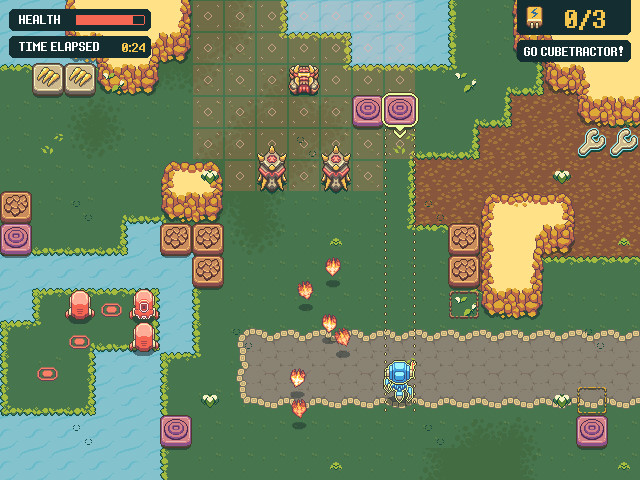
The other issue with the length of the game is that you don’t get enough time to experiment with the full set of structures. As boltguns aren’t introduced until the sixth exam, this means that the first 17 levels of the game, over a third of the levels, only have one or two cube types to work with. The seventh exam introducing enemy spires yet you can’t make your own until the eighth exam and decoys are likewise introduced all the way in the tenth exam by the enemy and you can’t make them yourself until the eleventh exam. In other words, there are only 11 levels in the entire game in which all six types of structures are in play and of those 11 you can only actually make all six of them yourself in the final six levels. The end result is that Cubetractor is a game which gradually grows in complexity and right when it starts to really show off the full extent of its potential it ends. Lastly, it’s worth noting that the developer, Ludochip, mentions developing a remake of this game on their website with more levels and structures and even potentially a multiplayer mode, but the notice seems to be an old one and the developers themselves seem to have disappeared from the Internet as far as I can tell so this more substantial remake is unfortunately unlikely to ever exist.
Cubetractor is short enough that I hesitate to recommend getting it at full price unless you plan to chase down all of its stars, but I would definitely suggest picking it up the next time it goes on sale as it’s a fantastic and well-executed concept which makes pulling cubes around far more exciting and engaging than usual.
es el megor juego del mundo